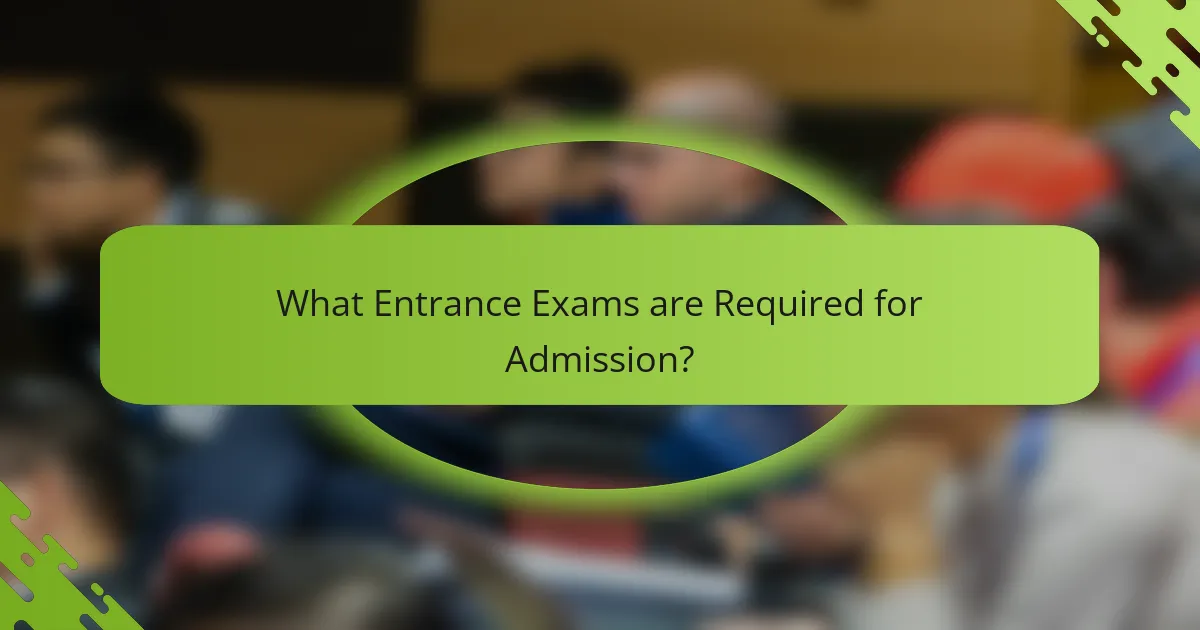Admission standards for software engineering courses in Canadian universities include essential criteria such as minimum GPA requirements, standardized test scores, and specific application timelines. Typically, a high school diploma with a strong emphasis on mathematics and sciences is required, with common GPA thresholds ranging from 70% to 80%. Standardized tests like the SAT or ACT may be necessary for undergraduate applicants, while some graduate programs might require the GRE. Application deadlines generally occur between January and March for September admissions, and each university may have specific requirements, making it crucial to consult individual program details for accurate information. Effective navigation of the application process involves creating a detailed schedule, maintaining organized records, and seeking guidance from admissions offices or alumni.

What are the Admission Standards for Software Engineering Courses in Canadian Universities?
Admission standards for software engineering courses in Canadian universities typically include a minimum GPA requirement, standardized test scores, and specific application timelines. Most universities require a high school diploma with a focus on mathematics and sciences. A common minimum GPA is around 75% or higher on a 100-point scale. Some institutions may also require standardized tests like the SAT or ACT for international students. Application deadlines usually fall between January and March for September admissions. Each university may have unique requirements, so it is essential to check specific program details.
Why are Admission Standards Important for Prospective Students?
Admission standards are important for prospective students as they set the criteria for eligibility in academic programs. These standards help ensure that students possess the necessary skills and knowledge for success in their chosen field. For example, a minimum GPA requirement indicates a baseline of academic performance. Entrance exams further assess a student’s readiness for advanced coursework.
Moreover, admission standards help institutions maintain academic integrity and quality. They create a competitive environment that encourages students to strive for excellence. In Canadian universities, these standards are particularly relevant for software engineering programs, where technical proficiency is crucial.
By adhering to admission standards, institutions can better prepare students for future challenges in their careers. This alignment between student capabilities and program expectations ultimately leads to higher graduation rates and successful job placements.
What role do Admission Standards play in university selection?
Admission standards are critical criteria that universities use to evaluate prospective students. They help institutions determine the academic preparedness of applicants. Admission standards typically include GPA requirements, entrance exam scores, and other qualifications. These standards ensure that students meet a certain level of academic achievement. They also help maintain the quality of education offered by the university. Institutions often publish their admission standards to guide applicants. This transparency allows students to assess their eligibility effectively. Ultimately, admission standards play a vital role in shaping the student body and academic environment of a university.
How do Admission Standards affect student preparedness?
Admission standards significantly influence student preparedness for software engineering courses. Higher admission standards typically require students to demonstrate a strong academic background. This often includes a minimum GPA and standardized test scores. Students meeting these criteria are generally better prepared for the rigors of university-level coursework. Research indicates that students with higher GPAs tend to perform better academically in their first year. For example, a study by the Canadian Council on Learning found that academic preparedness correlates with higher retention rates. Admission standards also encourage students to develop essential skills before enrolling. This includes critical thinking, problem-solving, and technical knowledge relevant to software engineering. Overall, rigorous admission standards foster a more prepared student body.
What are the Common Components of Admission Standards?
Common components of admission standards include GPA requirements, entrance exams, and application deadlines. GPA requirements typically specify a minimum average score for applicants. Entrance exams may include standardized tests like the SAT or ACT. Application deadlines are crucial for ensuring timely submission of materials. Many universities also consider letters of recommendation and personal statements. These components help institutions assess the qualifications and readiness of candidates for their programs. Each component plays a role in determining an applicant’s eligibility and fit for the program.
What is the significance of GPA Requirements?
GPA requirements are significant as they serve as a standardized measure of a student’s academic performance. They help universities assess a candidate’s readiness for rigorous coursework. A higher GPA often indicates strong study habits and understanding of the subject matter. Many Canadian universities use GPA as a primary criterion for admission into software engineering programs. For instance, a minimum GPA of 3.0 on a 4.0 scale is commonly required. This requirement aligns with the competitive nature of these programs. Furthermore, GPA can influence scholarship opportunities and financial aid eligibility. Overall, GPA requirements play a critical role in the admission process for prospective software engineering students.
How do Entrance Exams factor into the admission process?
Entrance exams are critical components of the admission process for software engineering courses in Canadian universities. They assess a candidate’s readiness for advanced study in the field. These exams often evaluate skills in mathematics, logic, and problem-solving, which are essential for success in software engineering. High scores can enhance a candidate’s application, making them more competitive. Many universities use entrance exam results alongside GPA and other criteria to make admission decisions. For instance, some institutions may require specific minimum scores to qualify for admission. This dual approach helps universities select candidates who are likely to succeed in rigorous academic environments.
What is the Application Timeline for Software Engineering Programs?
The application timeline for software engineering programs typically begins one year prior to the intended start date. Most universities open their applications in the fall, around September to October. Deadlines for submission generally fall between January and March of the following year. Some institutions may have rolling admissions, allowing applications to be submitted until the program reaches capacity. Applicants should also consider additional time for gathering required documents and preparing for entrance exams. It is essential to check specific university websites for exact dates, as they can vary significantly.
When should students start preparing their applications?
Students should start preparing their applications at least six months before deadlines. This allows ample time to gather necessary documents. Students need to research specific program requirements. They should also prepare for any required entrance exams. Early preparation helps in crafting strong personal statements. It also allows time for obtaining letters of recommendation. Many Canadian universities have application deadlines in early January. Starting early ensures students meet all requirements without last-minute stress.
What are the key dates in the application process?
Key dates in the application process for software engineering courses in Canadian universities typically include application deadlines, document submission dates, and admission decision notifications. Most universities require applications to be submitted by January or February for September intake. Supporting documents often need to be submitted by early March. Admission decisions are generally communicated by late March to early May. Specific dates vary by institution, so applicants should verify with each university for precise timelines.

What are the Specific GPA Requirements for Software Engineering Courses?
Specific GPA requirements for software engineering courses typically range from 70% to 80% in Canada. This percentage translates to a GPA of approximately 2.7 to 3.3 on a 4.0 scale. Some universities may have higher requirements, especially for competitive programs. For example, the University of Toronto requires a minimum GPA of 3.0. Similarly, the University of British Columbia often expects a GPA of 3.3 or higher for admission. These requirements ensure that applicants have a strong academic foundation in relevant subjects like mathematics and computer science.
How is GPA calculated for admission purposes?
GPA for admission purposes is calculated by averaging the grades received in coursework. Each course grade is assigned a numerical value based on a standard scale. Typically, an A is worth 4.0, a B is worth 3.0, and so on. The total grade points are divided by the number of courses taken. This provides a cumulative GPA, which reflects overall academic performance. Some institutions may weigh advanced courses more heavily. For instance, honors or AP classes could receive additional points. This weighted GPA can enhance a student’s overall score. Accurate GPA calculations are crucial for meeting admission standards in competitive programs.
What are the minimum GPA thresholds for different universities?
Minimum GPA thresholds vary by university. For example, the University of Toronto requires a minimum GPA of 3.0. McGill University also has a threshold of 3.0. The University of British Columbia sets its minimum at 2.5. Waterloo University expects a minimum GPA of 3.0 for software engineering. Concordia University has a threshold of 2.7. These requirements are subject to change based on program competitiveness and applicant pool. Always check the specific university’s admissions page for the most accurate and current information.
How do GPA requirements vary by program or specialization?
GPA requirements vary significantly by program or specialization within software engineering courses. For example, competitive programs may require a minimum GPA of 3.0 or higher. In contrast, less competitive programs might accept students with a GPA as low as 2.5. Some specializations, such as artificial intelligence or data science, often have higher GPA standards due to increased demand and limited spots. Additionally, certain universities may have unique criteria based on their admission policies. Overall, the variation in GPA requirements reflects the competitiveness and specific focus of each program or specialization.
What are the implications of GPA on admission chances?
GPA significantly impacts admission chances for software engineering courses. A higher GPA generally indicates strong academic performance. Many Canadian universities use GPA as a primary criterion for evaluating applicants. For instance, competitive programs may require a minimum GPA of 3.0 or higher. Admissions committees often view GPA as a predictor of future success in rigorous coursework. Additionally, applicants with lower GPAs may need to supplement their applications with strong entrance exam scores or relevant experience. Research shows that GPA correlates with retention rates in engineering programs. Therefore, maintaining a high GPA is crucial for increasing admission prospects.
How does a higher GPA improve a candidate’s application?
A higher GPA enhances a candidate’s application by demonstrating academic excellence. It indicates strong understanding and mastery of course material. Admissions committees often prioritize GPA as a key metric for evaluating potential success. A GPA above 3.0 is typically viewed as competitive in software engineering programs. Research shows that higher GPAs correlate with better performance in rigorous coursework. Additionally, a strong GPA can differentiate candidates in a pool of applicants. This differentiation is crucial in selective admissions processes. Overall, a higher GPA signals dedication and capability to succeed in challenging academic environments.
What strategies can students use to enhance their GPA?
Students can enhance their GPA by adopting effective study strategies. Regularly attending classes improves understanding and retention of material. Engaging in active participation during lectures fosters deeper learning. Establishing a consistent study schedule helps in managing time effectively. Utilizing resources like tutoring services can clarify difficult concepts. Forming study groups encourages collaborative learning and motivation. Seeking feedback from instructors allows for targeted improvement. Prioritizing assignments and projects based on their weight can optimize grades. Research shows that students who implement these strategies often see GPA improvements.

What Entrance Exams are Required for Admission?
The entrance exams required for admission to software engineering courses in Canadian universities typically include the SAT or ACT for undergraduate programs. Some institutions may also require the GRE for graduate-level admission. Specific requirements vary by university. For example, the University of Toronto and the University of British Columbia primarily consider high school grades and standardized tests like the SAT. In contrast, McGill University may require the GRE for certain graduate programs. Each university provides detailed admission criteria on their official websites.
What are the most common entrance exams for Software Engineering?
The most common entrance exams for Software Engineering are the SAT, ACT, and GRE. The SAT is widely accepted for undergraduate programs in North America. The ACT serves as an alternative to the SAT for U.S. college admissions. The GRE is often required for graduate programs, including Master’s in Software Engineering. These exams assess mathematical and analytical skills relevant to the field. Many universities in Canada recognize these tests for admission into Software Engineering courses. Specific score requirements may vary by institution, reflecting their admission standards.
How do standardized tests impact the admission process?
Standardized tests significantly influence the admission process for software engineering courses in Canadian universities. These tests provide a uniform measure of academic proficiency among applicants. Universities often use test scores to evaluate candidates alongside their GPA and other application materials. High scores can enhance an applicant’s chances of admission by demonstrating strong analytical and problem-solving skills. Conversely, low scores may limit opportunities, even for candidates with high GPAs. For instance, many institutions set minimum score thresholds for consideration. Research indicates that standardized tests can correlate with future academic performance, reinforcing their role in admissions decisions.
What are the scoring criteria for these entrance exams?
The scoring criteria for entrance exams typically include multiple components. These components often assess quantitative skills, verbal reasoning, and analytical writing. Each section is scored separately, contributing to a composite score.
For example, a common scoring range is from 200 to 800 for standardized tests like the GRE. The specific weight of each section may vary by program. Some programs prioritize quantitative scores over verbal scores.
Additionally, some entrance exams may include a minimum score requirement for each section. This ensures that candidates meet a baseline competency level. Programs may also consider percentile rankings to evaluate a candidate’s performance relative to others.
These scoring criteria are designed to provide a comprehensive assessment of a candidate’s preparedness for graduate-level studies.
How can students prepare for these entrance exams?
Students can prepare for entrance exams by creating a structured study plan. They should begin by reviewing the exam syllabus and understanding the format. Gathering study materials, such as textbooks and online resources, is crucial. Regular practice through mock tests helps familiarize students with the exam conditions. Time management skills should be developed to ensure all topics are covered. Joining study groups can provide support and additional resources. Seeking help from tutors can clarify difficult concepts. Finally, maintaining a healthy routine, including proper sleep and nutrition, enhances focus and retention.
What resources are available for exam preparation?
Resources available for exam preparation include study guides, online courses, and practice exams. Study guides provide structured content and key concepts. Online courses often offer video lectures and interactive exercises. Practice exams simulate the test environment and help with time management. Many universities also provide tutoring services. Additionally, forums and study groups can facilitate peer support. These resources enhance understanding and retention of material.
How important is practice testing in preparation?
Practice testing is crucial in preparation for admission standards in software engineering courses. It enhances retention of information and improves test-taking skills. Studies show that students who engage in practice testing perform better on actual exams. For instance, a research study by Roediger and Butler (2011) demonstrated that retrieval practice significantly boosts long-term retention. This method helps identify knowledge gaps and reinforces learning. Regular practice tests can also reduce anxiety by familiarizing students with the exam format. Overall, practice testing is a key strategy for effective preparation in academic settings.

What are the Best Practices for Navigating the Application Timeline?
To navigate the application timeline effectively, start by creating a detailed schedule. This schedule should include all key dates such as application deadlines, exam dates, and document submission timelines. Regularly check university websites for updates on admissions procedures. Maintain organized records of all application materials and communications. Set reminders for each stage of the application process to avoid missing deadlines. Consider reaching out to admissions offices for clarification on requirements. Engaging with current students or alumni can provide valuable insights. Finally, review and proofread all materials before submission to ensure accuracy. These practices enhance your chances of a successful application experience.
How can students effectively manage their time during the application process?
Students can effectively manage their time during the application process by creating a detailed schedule. This schedule should include all application deadlines, such as for transcripts and recommendation letters. Students should allocate specific time blocks for each task, such as writing essays and preparing for entrance exams. Prioritizing tasks based on deadlines and importance is crucial. Regularly reviewing and adjusting the schedule helps accommodate any unforeseen challenges. Utilizing tools like calendars or apps can enhance organization. Setting milestones for completing sections of the application can keep students motivated. Lastly, seeking feedback from peers or mentors can improve the quality of applications.
What tools or methods can aid in tracking application deadlines?
Digital calendars aid in tracking application deadlines. They allow users to set reminders for important dates. Google Calendar is widely used for this purpose. It offers features like notifications and event sharing. Project management tools also help in tracking deadlines. Tools like Trello and Asana allow users to create boards for applications. These tools can display deadlines visually. Spreadsheet applications like Microsoft Excel can also be used. Users can create custom tables to list deadlines and requirements. Mobile apps specifically designed for college applications exist. Examples include Common App and College Board. These apps provide centralized information on deadlines.
What are common pitfalls to avoid in the application timeline?
Common pitfalls to avoid in the application timeline include missing deadlines. Applicants often overlook specific submission dates for documents. Incomplete applications can lead to disqualification. Failing to follow up on application status is another mistake. Applicants should regularly check their email for updates. Not preparing for entrance exams in advance can hinder performance. It is crucial to allocate sufficient time for study. Lastly, neglecting to seek recommendations early can result in last-minute pressure. Timely communication with referees is essential for a smooth process.
The main entity of this article is the admission standards for software engineering courses in Canadian universities. The article provides a comprehensive overview of key components, including GPA requirements, entrance exams, and the application timeline. It outlines the typical GPA thresholds ranging from 70% to 80%, the significance of standardized tests like the SAT and ACT, and the critical application deadlines that prospective students must adhere to. Additionally, it discusses the importance of these admission standards in assessing student preparedness and maintaining academic quality within the programs.



